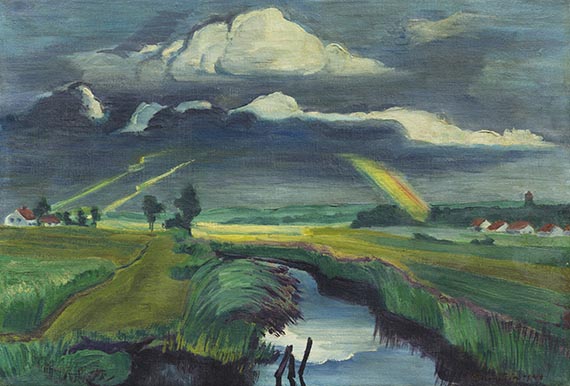124001167
Hermann Max Pechstein
Verziehendes Gewitter, 1941.
Oil on canvas
Estimation: € 70,000 / $ 77,000
Les informations sur la commission d´achat, les taxes et le droit de suite sont disponibles quatre semaines avant la vente.
Verziehendes Gewitter. 1941.
Oil on canvas.
Signed and dated in the lower right (partly in ligature, reinforced in black). Signed, titled and inscribed with the artist's address on the reverse of the canvas. 45 x 66 cm (17.7 x 25.9 in). [CH].
• To date, only two other paintings by the artist from this year of origin have been documented (one of which is lost).
• Pechstein captured a brief moment, a storm in the distance with lightning, towering dark clouds, and a short rainbow.
• In the center of the picture, above the sophisticated cloud reflection, delicate sunshine announces the storm's end.
• The scene presumably depicts the mill stream with a view of vast meadows and a river at Lake Sarbsko (today Jezioro Sarbsko) near Leba in West Pomerania.
• In 2024, the artist was honored with a comprehensive retrospective at the Museum Wiesbaden.
Accompanied by a certificate from Prof. Dr. Aya Soika, Berlin, dated September 29, 2015 (copy). The painting is registered in the archive of the Max Pechstein copyright community, Hamburg, under the number 1941/3.
PROVENANCE: Private collection, Berlin.
Private collection, Germany (through inheritance from the above in 1994).
Private collection, Northern Germany (acquired from the above in 2015).
"[..] personally, I have never had such a bad summe in my entire life as a painter, two months of rain and cold.”
Max Pechstein in a letter to his son Frank, 1941, quoted in: Aya Soika, Max Pechstein. Das Werkverzeichnis der Ölgemälde, vol. 2 (1919-1954), p. 30.
Oil on canvas.
Signed and dated in the lower right (partly in ligature, reinforced in black). Signed, titled and inscribed with the artist's address on the reverse of the canvas. 45 x 66 cm (17.7 x 25.9 in). [CH].
• To date, only two other paintings by the artist from this year of origin have been documented (one of which is lost).
• Pechstein captured a brief moment, a storm in the distance with lightning, towering dark clouds, and a short rainbow.
• In the center of the picture, above the sophisticated cloud reflection, delicate sunshine announces the storm's end.
• The scene presumably depicts the mill stream with a view of vast meadows and a river at Lake Sarbsko (today Jezioro Sarbsko) near Leba in West Pomerania.
• In 2024, the artist was honored with a comprehensive retrospective at the Museum Wiesbaden.
Accompanied by a certificate from Prof. Dr. Aya Soika, Berlin, dated September 29, 2015 (copy). The painting is registered in the archive of the Max Pechstein copyright community, Hamburg, under the number 1941/3.
PROVENANCE: Private collection, Berlin.
Private collection, Germany (through inheritance from the above in 1994).
Private collection, Northern Germany (acquired from the above in 2015).
"[..] personally, I have never had such a bad summe in my entire life as a painter, two months of rain and cold.”
Max Pechstein in a letter to his son Frank, 1941, quoted in: Aya Soika, Max Pechstein. Das Werkverzeichnis der Ölgemälde, vol. 2 (1919-1954), p. 30.
124001167
Hermann Max Pechstein
Verziehendes Gewitter, 1941.
Oil on canvas
Estimation: € 70,000 / $ 77,000
Les informations sur la commission d´achat, les taxes et le droit de suite sont disponibles quatre semaines avant la vente.




 Lot 124001167
Lot 124001167 